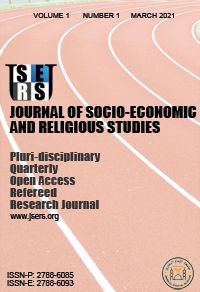Issues of Journal of Socio-Economic and Religious Studies
Journal
Journal of Socio-Economic and Religious Studies
Editor
Abdur Rahman Khan
Publisher
Jamia tul Imam ul Bukhari
ISSNP
2788-6085
ISSNE
2788-6093
Frequency
Quarterly
Article Processing Charges
None
Submission Charges
None
Journal Start Date
2021
Review Process
Double Blind Peer Review
Subjects
Social Sciences; Economics; Religious Studies
Languages
English
Editorial Board URL
Author Instructions URL
Author Licence URL
Open Access
Yes
ARI Id
96
This page has been accessed 37 times.
Introduction
Journal of Socio-Economics and Religious Studies(JSERS) is a Quarterly Research and Referred Journal published by Jamia Imam Bukhari, Karachi. Journal covers authoritative, topical and original research papers in all fields of Social Sciences, Economics and Religious Studies that interests a wide range of authors symbolizing an outstanding development within an explicit field. The mission of the Journal of Socio-Economics and Religious Issues (JSERS) is to promote interdisciplinary dialogue about socio-economic and religious processes, institutions and policies. The core disciplines of interest to the journal are those belonging to the Social Sciences and religious Studies and Sciences. But other sciences and the humanities are also relevant and welcomed. Economics, Sociology, History and Philosophy are of particular interest. The journal is interested in pure theory, empirical studies, policy analyses and literature reviews.
Aims and Scope
Journal of Socio-Economic and Religious studies’ aims to be the principal medium for dissemination of research in all aspects of Social Scienes and Economics. The journal will be of primary interest to anyone involved in Socio Economic Topics as well as Religious Studies and Sciences and will offer many insights to the scholars and researchers. The journal publishes research papers, reviews and case studies for all Social Sciences and Socio-Economic and Economic domains including but not limited to the following fields: Criminology, Economics, English, History, International Relations, Islamic History, Library & Information Science, Mass Communication, Persian, Philosophy, Political Science, Psychology, Sindhi, Shah Latif Chair, Social Work, Sociology, Urdu, Visual Studies. Also the Journal publishes topics related to Religious Studies and Sciences but not limited to Islamic and Arabic literature, Islamic philosophy, Islamic ethics, Islamic society, Islamic law, Islam and contemporary religions, Islam and science, education and training in Islam, Islamic banking and finance, Islamic economic, Political system in Islam, Islam in modern world, Islamic concept of psychology and Human rights in Islam. The mission of the Journal of Socio-Economics and Religious Issues (JSERS) is to promote interdisciplinary dialogue about socio-economic and religious processes, institutions and policies. The core disciplines of interest to the journal are those belonging to the Social Sciences, Economics and religious Studies and Sciences. But other sciences and the humanities are also relevant and welcomed. Economics, Sociology, History and Philosophy are of particular interest. The journal is interested in pure theory, empirical studies, policy analyses and literature reviews.
Contact Information
Sheikh Adnan Ahmed Usmani Phone 03332001596 jsers. Org@gmail. Com
| Id | Volume & Issue | Year | No of Articles |
| Id | Volume & Issue | Year | No of Articles |

